Excellent reading on the Ypres Salient, books which I personally have and would recommend.
| Michael Scott (1992) The Ypres Salient, A Guide To The Cemeteries And Memorials Of The Salient. Gliddon Books. (Excellent guide to the cemeteries of the Ypres Salient). | |
| Rose E B Coombs MBE (1994) Before Endeavors Fade, A Guide To The Battlefields Of The First World War. An After The Battle Publication. (Probably the best guide to the Western Front - latest revision has been completely revised) | |
| Sidney C Hurst ( ) The Silent Cities, An Illustrated Guide To The War Cemeteries And Memorials To The Missing In France And Flanders: 1914-1918. (Reprint of old book - indicating all cemeteries in Northern France and Belgium - all photos B/W and old - some cemeteries no longer existing - more of a reference book) | |
| Major & Mrs. Holt (1997) Battlefield Guide Ypres Salient. Leo Cooper. (Best guide to those wanting to tour the Ypres Salient) | |
| Michael Glover (1987) A New Guide to the Battlefields of Northern France. Book Club Associates. (Good introductory guide to Battlefields of Northern France and Belgium) | |
| Tom Donovan (1999) The Hazy Red Hell. Spellmount. (Each chapter deals with a different account of the Great War - a good read) | |
| Beatrix Brice (1987) The Battle Book of Ypres. Spa Books. (Reprint of old book - laid out in alphabetical order of locations - more of a reference book) | |
| John Giles (1970) The Ypres Salient - Flanders Then and Now. Picardy. (has been re-published since - as the title suggests photo's then and as the area is today). | |
| Andy Simpson (1995) The Evolution of Victory. Tom Donovan Publishing. (Discusses planning, execution of each main battle / phase of the Great War - easy reading) | |
| G Kingsley Ward and Major E Gibson (1995) Courage Remembered. HMSO. (The bible to the planning / construction and history of the CWGC) | |
| Martin Evans (1997) Passchendaele and other Battles of Ypres 1914-18. Osprey Military. (Good illustrated guide / introduction to the Battles of Yrpes) | |
| Ray Westlake (1998) Kitchener's Army. Spellmount. (An excellent guide to the formation and history of Kitchener's New Army - excellent reference) | |
| Gerald Gliddon (1998) VCs of the First World War - Arras and Messines 1917. Wrens Park. (Excellent reference guide to VC's won - easy reading) | |
| Gerald Gliddon (1994) VCs of the First World War - 1914. Wrens Park. (Excellent reference guide to VC's won - easy reading) | |
| Gerald Gliddon (1997) VCs of the First World War - The Western Front 1914. Wrens Park. (Excellent reference guide to VC's won - easy reading) | |
| Philip Warner (1987) Passchendaele - The Story Behind the Tragic Victory of 1917. Sidwick. (Excellent reference guide to VC's won - easy reading) | |
| Dominiek Dendooven and Jan Dewilde ( ) The Reconstruction of Ieper - A Walk through History. Openbaar Kunstbezit in Vlaanderen. (Excellent little guide to the reconstruction of Ypres after the War) | |
| Leon Wolfe (1958) In Flanders Fields. Penguin. (The original book on the subject) | |
| Piet Chieldens and Julian Putkowski ( ) Unquiet Graves - Executaion Sites of the First World War in Flanders. Francis Boutle Publishers. (A must guide for those interested in Ypres and "shot at dawn") | |
| John Ivelaw-Chapman (1997) The Riddles of Wipers. Leo Copper. (The story of the famous newspaper) | |
| Anne Roze (1999) Fields of Memory - A Testimony to the Great War. Seven Dials. (An excellent, beautifully illustrated guide to the Great War - A beautiful book to own) | |
| Dominiek Dendooven (2001) Menin Gate and Last Post. De Klaproos. (The definitive guide to its subject - I learn a lot of new information from this book - plus many unseen photo's) | |
| Malcolm Brown & Shirley Seaton (1994) Christmas Truce. Pan. (account of the Christmas Truce 1914 - as complied from war diaries, personal accounts and letters) | |
| Malcolm Brown (1999) The Imperial War Museum Book of 1918. Pan. (account of the Final year of the war - as complied from war diaries, personal accounts and letters) | |
| Malcolm Brown (1999) The Imperial War Museum Book of The Western Front. Pan. (account of how the war was won and lost on the Western Front - as complied from war diaries, personal accounts and letters) | |
| Tony Ashworth (1980) Trench Warfare 1914-1948. Pan. (account of the culture of trench life) | |
| Anthony Babington (2002) For the Sake of Example - Capital Courts Martial 1914-1920: The Truth. Penguin. (the first account on the subject based on MOD files - text refers to a Private of Yorkshire Regiment, ie does not name him, however by use of the Appendix it is fairly easy to determine the soldier concerned, as gives name, unit, offence and date of death) | |
| Julian Nicholls (1997) A Walk to Passchendaelle. The Pentland Press Ltd. (Brief account / guide from a first time visitor to the area, outlining history of the battle and the area - 60 pages) | |
| Gene Smith (1965) Still Quiet on the Western Front - 50 Years Later. William Morrow and Co. (An American author revisits the whole of the Western Front 50 years after the end of the War) | |
| Nigal Steel and Peter Hart (2001) Passchendaele - The Sacrificial Ground. Cassell and Co. | |
| Lyn MacDonald (1978) They Call it Passendaele. Pengiun (1993 edition). The Third Battle of Y pres, culminating in a desperate struggle for the ridge and little village of Passchendaele, was one of the most appalling campaigns in the history of warfare. In this masterly piece of oral history, Lyn Macdonald lets over 600 participants speak for themselves. A million Tommies, Canadians and Anzacs assembled at the Ypres Salient in the summer of 1917, mostly raw young troops keen to do their bit for King and Country. This book tells their tale of mounting disillusion amid mud, terror and desperate privation, yet it is also a story of immense courage, comradeship, songs, high spirits and bawdy humour. Much has been written about the politics and sheer strategic idiocy of Passchendaele {the ridges were abandoned again in the spring of 1918, and, leaving thousands of dead behind them, the Allies retired to a position the Commander of the Second Army had recommended in 1915), far less about the underlying human realities. This book portrays events from the only point of view that really matters. | |
| W H Dowming
(1998) To the Last Ridge - The WWI Experiences of W H Dowming. Grub Street
(1st published 1920). Written
just after the heat of battle and in the language of the time, this
extraordinarily moving account expresses in a brutally honest and personal
way the ordinary soldier's experience of one of the most horrific series
of battles ever fought. Fleurbaix Bapaume Beaumetz Lagnicourt
Bullecourt The Menin Road Villers-Bretonneux. Peronne
and Mont St. Quentin. Downing describes the mud, the rats, the constant
pounding of the guns, the deaths, the futility, but also the humour and
heroism of one of the most compelling periods in world history. His
writing is spare, beautiful in its clarity and heart-breakingly vivid.
Walter Downing was a Melbourne law student before fighting on the Western
Front, where he won the Military Medal. His book was acclaimed, on its
original publication in 1920, for its literary quality and its realism,
which few soldiers have managed to achieve. |
|
| (1997) Passchendaele In Perspective The Third Battle Of Ypres. Pen & Sword. Thirty thought provoking essays of this subject by well respected historians. |
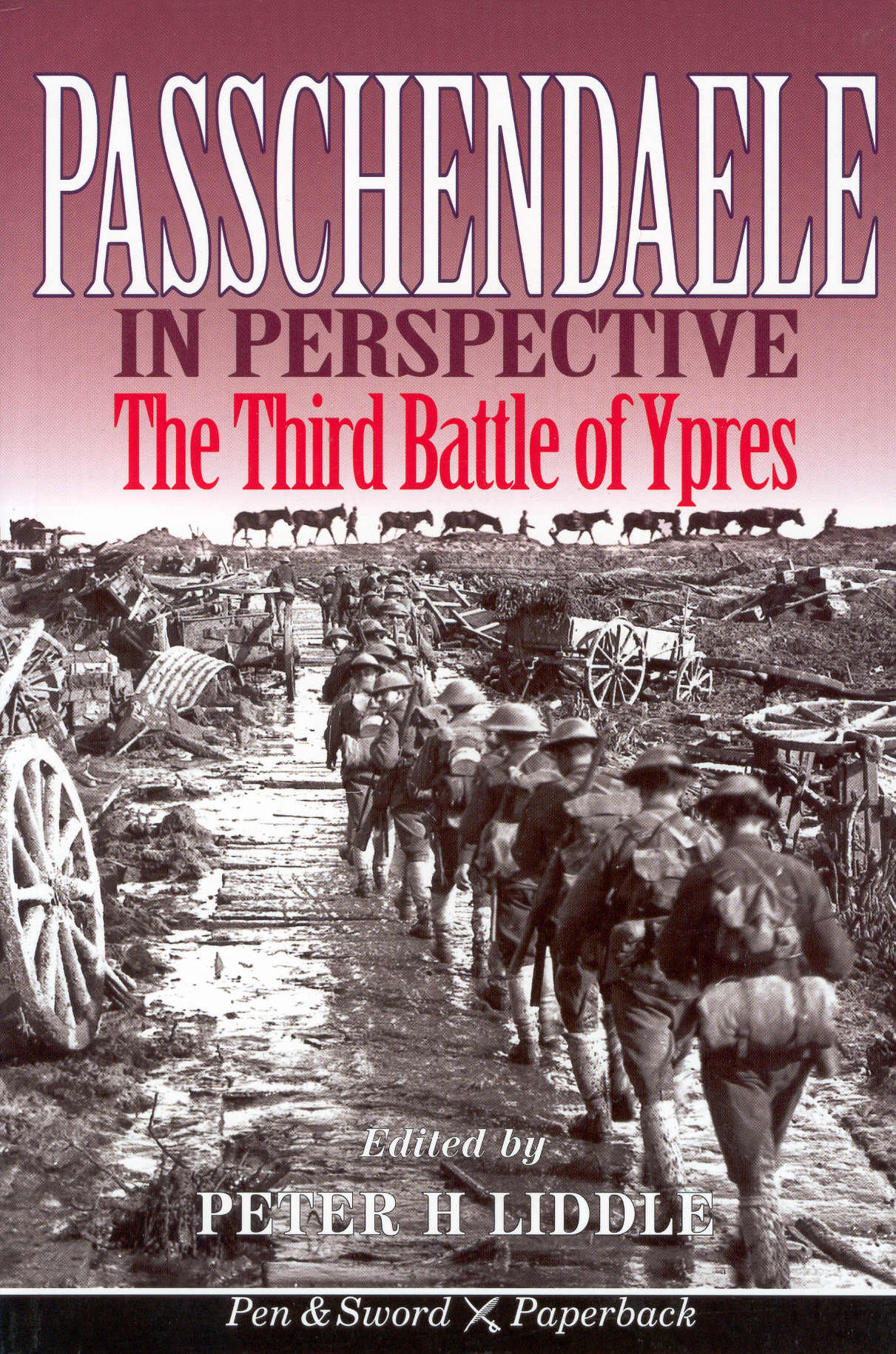
| (2001) At The Going Down Of The Sun. Lannoo. Released to coincide with the 75th anniversary of the Menin Gate, contains the stories of 365 soldiers whoi died in Flanders, one for each day of this 75th year. |
| Steel N and Hart P (2000) Passchendeale The Sacrificail Ground. Cassell & Co. |
| McWilliams and Steel (1985) GAS The Battle For Ypres, 1915Tri-Service Press. |
Battleground Europe Series.
An excellent series of books for both the expert and novice a like. For me, who knows the area's discussed, i'm almost there were them.
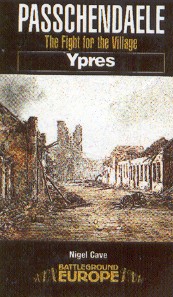 Nigel Cave (1997) Passchendaele, The Fight For The
Village. Leo Cooper Pen & Sword Books Ltd
Nigel Cave (1997) Passchendaele, The Fight For The
Village. Leo Cooper Pen & Sword Books Ltd
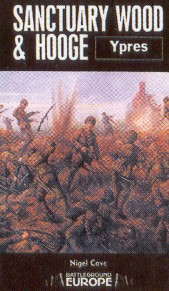 Nigel Cave (1993) Sanctuary Wood And Hooge. Leo
Cooper Pen & Sword Books Ltd
Nigel Cave (1993) Sanctuary Wood And Hooge. Leo
Cooper Pen & Sword Books Ltd
Sanctuary Waod and the village
of Hooge, situated for much of the First World War in the front line of the
notorious Ypres Salient, saw heavy fighting during the First and Second Battles
of Ypres in 1914 and 1915, and continued to do so until almost the end of the
war. In his latest guide, the first in an innovative new series, the author
takes the reader on an explanatory tour of the immediate area, including the
neighbouring British cemeteries. Starting at the most visited part of the Ypres
Salient, the museum at Sanctuary Wood, this book conducts visitors not only over
today's ground, but also through the landscapes and events of more than seventy
years ago, and incorporates those pieces of evidence, whether trench or other
surviving relics, cemetery, memorial or museum, that remain as reminders of a
brutal history.
Crammed with detail that allows visitors to find and view these historic areas, the text also covers a wealth of representative actions, from the first use of flamethrowers against British soldiers, to the exploits of Canadian troops in 1916 as well as supporting information about individual burials. Copiously supplied with both illustrations and clear, accurate maps, the guide also explains names given to geographical features, in addition to military terms and methods of operations, allowing readers to find and see for themselves the features once so redolent of horror and heroism. The author's great knowledge of the area today and its history, as well as his experience in imparting information, serve to make this guide to some of the Ypres battlefields an invaluable aid for casual tourist and serious scholar alike.
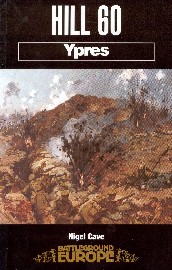 Nigel Cave (1989) Hill 60. Leo Cooper Pen &
Sword Books Ltd
Nigel Cave (1989) Hill 60. Leo Cooper Pen &
Sword Books Ltd
The shell-ravaged landscape of Hill 60, some three miles to the south east of Ypres, conceals beneath it a labyrinth of tunnels and underground workings constructed by the combatants in the Great War. An undistinguished mound largely created by the spoil of a railway cutting, this small area saw horrific fighting in 1914 and 1915 as the British and Germans struggled for control of its dominant view over the Ypres Salient. The first Territorial Army VG of the war was won here, as well as many others -three in one night by men of the East Surreys.
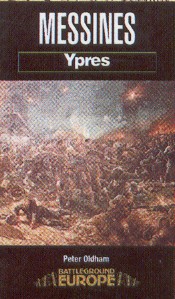 Peter Oldham (1998) Messines Ridge. Leo Cooper Pen
& Sword Books Ltd
Peter Oldham (1998) Messines Ridge. Leo Cooper Pen
& Sword Books Ltd
Messines Ridge, 7 June 1917: a masterpiece of planning and preparation and a well deserved British victory. The villages of Messines, Wytschaete and St Eloi, which sat on the high ground of Messines Ridge, were keenly desired by both British and Germans. This book gives a year-by-year account of the battles for their possession, explaining what happened where, when, and what can be seen in the woods and fields today.
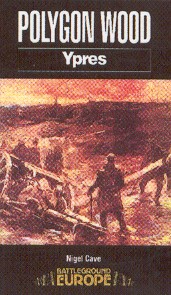 Nigel Cave (1999) Polygon Wood. Leo Cooper Pen
& Sword Books Ltd
Nigel Cave (1999) Polygon Wood. Leo Cooper Pen
& Sword Books Ltd
Polygon Wood 1917 is a story of some of the events that
took place in the wood and its immediate surroundings during the Third Battle of
Ypres. Although the landscape today bears no resemblance to the ferocious scenes
that scarred it in the autumn of 1917, it is a good place in which to reflect on
the gruesome past. There were notable tactical gains over this ground; whilst
the fighting methods of the British army continued to develop at notable speed.
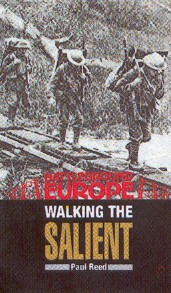 Paul Reed (1999) Walking The Salient. Leo Cooper Pen
& Sword Books Ltd
Paul Reed (1999) Walking The Salient. Leo Cooper Pen
& Sword Books Ltd
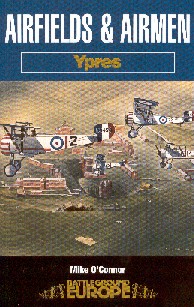 Mike
O'Connor (2001) Airfields and Airmen. Leo Cooper Pen
& Sword Books Ltd
Mike
O'Connor (2001) Airfields and Airmen. Leo Cooper Pen
& Sword Books Ltd
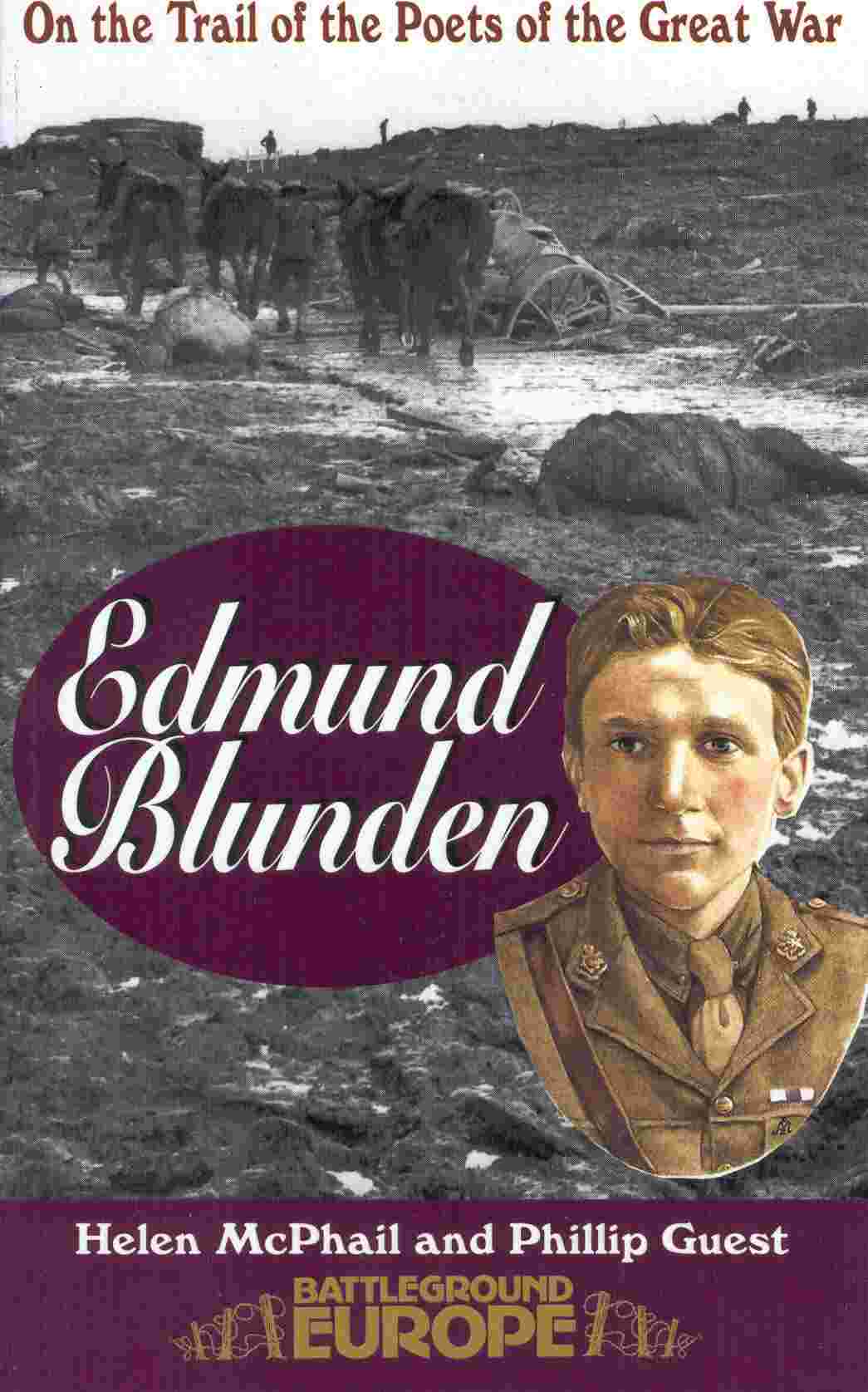 Helen
McPhail and Phillip Guest (2002) Edmond Blunden. Leo Cooper Pen
& SwordBooks Ltd
Helen
McPhail and Phillip Guest (2002) Edmond Blunden. Leo Cooper Pen
& SwordBooks Ltd
Cameos Series.
Another excellent series of books for both the expert and novice a like. They are very readable and in-dept - I have learn so much from the books.
|
Tony Spagnly and Ted Smith (1995) Cameos Of The Western Front - Salient Points One. Leo Cooper Pen |
|
|
Tony Spagnly and Ted Smith (1998) Cameos Of The Western Front - Salient Points Two. Leo Cooper Pen |
|
|
Tony Spagnly and Ted Smith (2001) Cameos Of The Western Front - Salient Points Three. Leo Cooper Pen |
|
|
Tony Spagnly and Ted Smith (1997) A Walk Around Plugstreet. Leo Cooper Pen |
|
|
Paul Chapman (2000) Cameos of the Western Front - A Haven in Hell. Leo Copper. |
|
|
Paul Chapman (2001) Cameos of the Western Front - In The Shadow Of Hell. Leo Copper. |
|
|
Tony Spagnly and Ted Smith (1998) Cameos Of The Western Front - The Anatomy of a Raid. Leo Cooper Pen. |
For King and Country Series.
A series of books I have only recently discovered, I believe 8 in all. They serve as both guides to the area and reference books.
| Norm Christie (1999) The Canadians At Ypres - 22nd-26th April 1915. CEF Books. |
| Norm Christie (2000) The Canadians At Mont Sorrel - 2nd-14th June 1916. CEF Books. |
| Norm Christie (1999) The Canadians At Passchendaele - October - November 1917. CEF Books. |
there are also many biographies which give good accounts of actions on the Ypres Salient.